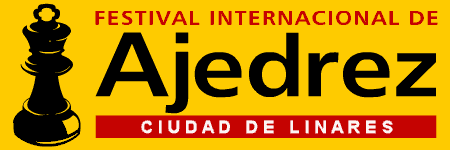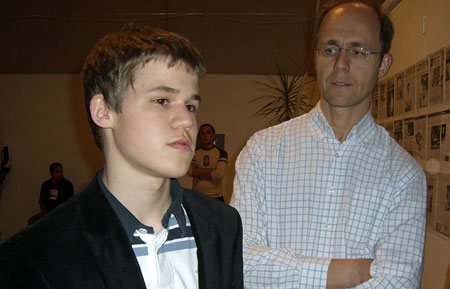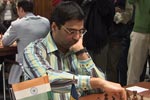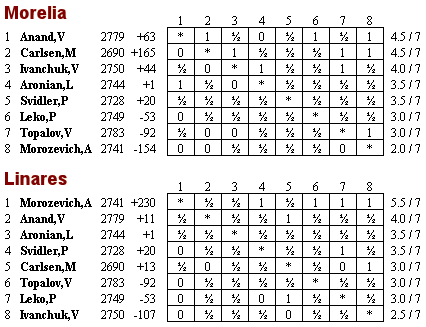

Round fourteen (final)
Round 14: Saturday, March 10th |
| Peter Leko |
1-0 |
Magnus Carlsen |
Peter Svidler |
0-1 |
Alex. Morozevich |
Veselin Topalov |
½-½ |
Levon Aronian |
Vassily Ivanchuk |
½-½ |
Vishy Anand |
|
Final standings

Note that the official
site lists Magnus Carlsen in second place, which can be explained by the
same tiebreak score.
Here are some statistics: Anand's performance was 2816, while Topalov ended
at a dismal 2691. This means that Anand will be number one on FIDE's April 1st
list, something he has been looking forward to and been close to achieving for
more than a decade. [The deadline
for submission of results is February 28, 2007, but we are sure that FIDE
will include Morelia/Linares in its calculation.]

The new number one in the world rankings: Vishy Anand of India

Veselin Topalov, who had occupied this place since Garry Kasparov's retirement,
which was announced in this hall exactly two years ago (on March 10th 2005)

Magnus Carlsen (with father Henrik) ended with a loss but a shared second
and gave an unprecedented 2778 performance
Magnus Carlsen's shared second and his sterling 2778 performance is truly remarkable
for a 16-year-old who was the tournament's underdog. At the start some writers
were bemoaning the decision of the organisers to include a "rabbit"
in such a great event. Cannon fodder, they called him. Henrik Carlsen told us
at the start of the tournament that his son had to decide whether to play safe
(i.e. defensively) and try to achieve an honorable minus two result, or to go
for broke and slug it out with the big boys. We know what the lad decided. Just
half of his games were drawn, producing four wins and three losses on his score
card.

Downs and ups, bottom and top: typical for Alexander Morozevich
Exactly the same result was achieved by the mercurial Alexander Morozevich,
though while Magnus was first or second on the table during the entire tournament,
"Moroz" started by firmly occupying last in the first half of the
event. Let us look back at the standing after seven rounds in Morelia, and compare
it with Morozevich performance in Linares:
The performance values are equally remarkable: in Morelia Morozevich was giving
an accurate impression of a 2587-rated player taking part in this Super-GM event.
His result would not have been enough to achieve a grandmaster norm. In Linares
he played as if he was rated 2971, winning four games and drawing three. What
a player! Incidentally Morozevich did not take a second to Morelia, but had
former FIDE world champion Rustam Kasimdzhanov join him in Linares. The two
are friends and their joint efforts paid off handsomely.

Peter Svidler finished the event with 50% and a 2748 performance

Last year's winner Levon Aronian also scored 50% with a 2745 performance
Peter Svidler had a constant tournament of sorts, drawing all his games in
Morelia and winning one and losing one in Linares. His 50% score is twenty points
better than his nominal 2728 rating. Aronian's 50% was almost exactly what you
would expect from a 2744 player.

He'll be back, with a vengence: Peter Leko, who disappointed in Morelia/Linares
The big disappointment, apart from Veselin Topalov, was Peter Leko, who played
53 points worse than his 2749 rating – and was saved from an even more
dismal result (and an unshared last place) by his final round victory over Magnus
Carlsen. But Peter is tough as nails and he will be back in fighting spirit
in the Candidates
Tournament which start on May 26 in Elista. Many predict a big all-Hungarian
showdown in the second round between Peter Leko and Judit Polgar.
Photos by Nadja Woisin and Frederic Friedel
Schedule
Round 8: Friday, March 2nd |
Peter Leko |
½-½ |
Vassily Ivanchuk |
Vishy Anand |
½-½ |
Veselin Topalov |
| Levon Aronian |
½-½ |
Peter Svidler |
Alex. Morozevich |
½-½ |
Magnus Carlsen |
|
|
Round 9: Saturday, March 3rd |
Alex. Morozevich |
1-0 |
Peter Leko |
Magnus Carlsen |
½-½ |
Levon Aronian |
Peter Svidler |
½-½ |
Vishy Anand |
Veselin Topalov |
½-½ |
Vassily Ivanchuk |
|
|
Round 10: Sunday, March 4th |
Peter Leko |
½-½ |
Veselin Topalov |
Vassily Ivanchuk |
½-½ |
Peter Svidler |
Vishy Anand |
1-0 |
Magnus Carlsen |
Levon Aronian |
½-½ |
Alex. Morozevich |
|
|
|
Free day: Monday, March 5th |
|
Round 11: Tuesday, March 6th |
Levon Aronian |
½-½ |
Peter Leko |
Alex. Morozevich |
½-½ |
Vishy Anand |
Magnus Carlsen |
1-0 |
Vassily Ivanchuk |
Peter Svidler |
½-½ |
Veselin Topalov |
|
|
Round 12: Wednesday, March 7th |
Peter Leko |
0-1 |
Peter Svidler |
Veselin Topalov |
½-½ |
Magnus Carlsen |
Vassily Ivanchuk |
0-1 |
Alex. Morozevich |
Vishy Anand |
½-½ |
Levon Aronian |
|
|
|
Free day: Thursday, March 8th |
|
Round 13: Friday, March 9th |
Vishy Anand |
½-½ |
Peter Leko |
Levon Aronian |
½-½ |
Vassily Ivanchuk |
Alex. Morozevich |
1-0 |
Veselin Topalov |
Magnus Carlsen |
½-½ |
Peter Svidler |
|
|
Round 14: Saturday, March 10th |
| Peter Leko |
1-0 |
Magnus Carlsen |
Peter Svidler |
0-1 |
Alex. Morozevich |
Veselin Topalov |
½-½ |
Levon Aronian |
Vassily Ivanchuk |
½-½ |
Vishy Anand |
|
|
|
Links


































